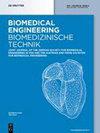Actuators and transmission mechanisms in rehabilitation lower limb exoskeletons: a review
IF 1.8
4区 医学
Q4 ENGINEERING, BIOMEDICAL
引用次数: 0
Abstract
Research has shown that rehabilitation lower limb exoskeletons (RLLEs) are effective tools for improving recovery or regaining lower limb function. This device interacts with the limbs of patients. Thus, actuators and power transmission mechanisms are the key factors in determining smooth human‒machine interaction and comfort in physical therapy activities. A multitude of distinct technologies have been proposed. However, we questioned which consideration point in actuator selection and power transmission mechanisms are used for RLLE. A review of the technical characteristics and status of advanced RLLE designs is discussed. We review actuator selection for RLLE devices. Furthermore, the power transmission mechanisms over the years within each of the RLLE devices are presented. The development issues and possible research directions related to actuators and power transmission mechanisms are provided. Most RLLEs are still in the research phase, and only a few have been commercialized. The aim of this paper is to provide researchers with useful information for investigating technological progress and highlight the latest technological choices in RLLE development.康复下肢外骨骼中的致动器和传动机构:综述
研究表明,康复下肢外骨骼(RLLEs)是改善康复或恢复下肢功能的有效工具。这种装置与患者的肢体相互作用。因此,致动器和动力传输机制是决定理疗活动中人机互动顺畅性和舒适性的关键因素。目前已经提出了许多不同的技术。然而,我们对 RLLE 在选择致动器和动力传输机制时的考虑点提出了质疑。我们讨论了先进 RLLE 设计的技术特点和现状。我们回顾了 RLLE 设备的致动器选择。此外,还介绍了各 RLLE 设备多年来的动力传输机制。我们还提供了与致动器和动力传输机制相关的开发问题和可能的研究方向。大多数 RLLE 仍处于研究阶段,只有少数已实现商业化。本文旨在为研究人员提供调查技术进展的有用信息,并重点介绍 RLLE 开发中的最新技术选择。
本文章由计算机程序翻译,如有差异,请以英文原文为准。
求助全文
约1分钟内获得全文
求助全文
来源期刊
CiteScore
3.50
自引率
5.90%
发文量
58
审稿时长
2-3 weeks
期刊介绍:
Biomedical Engineering / Biomedizinische Technik (BMT) is a high-quality forum for the exchange of knowledge in the fields of biomedical engineering, medical information technology and biotechnology/bioengineering. As an established journal with a tradition of more than 60 years, BMT addresses engineers, natural scientists, and clinicians working in research, industry, or clinical practice.

 求助内容:
求助内容: 应助结果提醒方式:
应助结果提醒方式:


